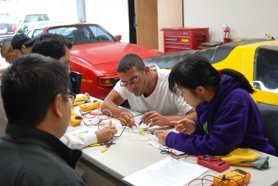 It was fascinating to participate last week at “Transportation Electrification Curriculum Roadmap Workshop,” which was organized by Brett Williams and J.R. DeShazo of UCLA Luskin Center for Innovation. It was hosted by Southern California Edison at its SCE Energy Education Center in Irwindale, Calif. The focus of that day was on challenges being faced by education programs training students in community colleges and universities to serve the growing industry of electric vehicles (EVs), electric vehicle supply equipment (EVSE), and charging infrastructure.
It was fascinating to participate last week at “Transportation Electrification Curriculum Roadmap Workshop,” which was organized by Brett Williams and J.R. DeShazo of UCLA Luskin Center for Innovation. It was hosted by Southern California Edison at its SCE Energy Education Center in Irwindale, Calif. The focus of that day was on challenges being faced by education programs training students in community colleges and universities to serve the growing industry of electric vehicles (EVs), electric vehicle supply equipment (EVSE), and charging infrastructure.
I was wearing my consultant hat – it was not a public media event – but I would like to present some of the important information shared that day (identities of participants beyond the two organizers will remain anonymous for now). Much of the insightful information came from instructors and directors at education and training programs on campuses all over Southern California. Along with education professionals, there were people from government agencies, utilities, automakers, fleet management, and research centers. Here’s a few interesting points that were made that day…..
- Community college and university administrators have been very restrictive about how much funding they’ve been willing to contribute to the education programs. Program directors had to get creative about securing funding, and much of this has come from grant funding outside the school and from corporate contributors.
- Part of the day was spent analyzing job categories and statistics compiled by Luskin Center based primarily on the US Bureau of Labor Statistics job categories. There’s concern that the job definitions and categories are limited right now – there’s a lot of new and emerging jobs in the US economy that include solar energy and electrified transportation. So the federal and state reports that education programs are using now (and which influence funding) are limited and need to see some change. Educators would like to see the jargon for job classifications standardized in a way making it clear and accessible for everyone.
- Getting young people engaged in seeking training and education in electrified transportation is a bit of a challenge. The college programs are growing, but educators are wanting to inform communities about their programs – and that would include high school teachers and administrators, students, parents, local government agencies, and others.
- Program directors are spending as much of their time getting their students jobs and securing funding as they are teaching classes. That’s where creating internships and externships for students is paying off, along with student workshops and research projects.
- Students are interested in becoming certified service technicians for dealers and fleets; others are getting graduate degrees in engineering to meet the growing demand for advanced vehicle technology integration. There’s also a lot of need for EVSE and charging infrastructure workers to keep EVs on the road.
- The National Institute for Automotive Service Excellence (ASE) is working on certification for electric and hybrid vehicle technicians. That’s very much needed out there.
- Another area of interest and training programs is “first responder” safety training for paramedics, firefighters, and others who rescue drivers from EV collisions. As students have asked me about when I’ve done high school presentations, there is a good deal of concern about safety when working with EVs. “Second responders” is also a big group – such as tow truck drivers and storage and wrecking yards. Cars can potentially catch on fire up to a week later, so education and training is needed in this area.
- Another question: What to do about electric passenger cars and commercial vehicles (such as bucket trucks and delivery vans) that come off warranty coverage and need regular service?
- Social media has its advantages in getting the word out to young people and EV enthusiasts. One participant shared that 50% of EV information in social media is being posted on Twitter. Posting photos and videos on social media is getting a lot of hits – with instructors teaching students what they should know about EV technology. Smartphone EV charging apps are also getting a lot of interest.
- One point that I made at the end (and rambled on a little too long about – my apologies to the group) is that I’d like to see questions that EV buyers ask answered in these programs so that instructors and students can address them. As I learned once again last week in the Green Auto Market reader survey results, there’s a lot of concern among industry stakeholders about how we can effectively answer frequently asked questions that consumers, fleets, and other vehcle buyers have. They want to know if it’s worth their investment of time and money – acquisition costs and incentives, lifecycle ownership costs, and how it all compares to traditional gasoline ICE vehicles; and then there’s always range anxiety. Then there’s the question of the chicken or the egg – what needs to happen to make this all work – more affordable electric vehicles on the market or enough charging stations to alleviate fears of being stranded.
- This working group on EV workforce training will be meeting again to keep these critical issues moving forward for the next generation of the EV workforce.



